Understanding Human-Induced Change
By Ezekiel Fugate, Doctoral Student at Yale University
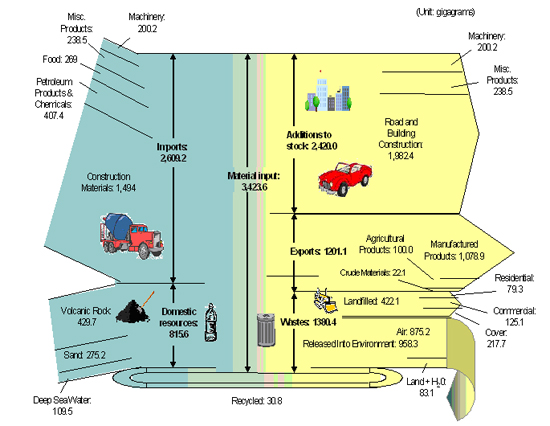 Image: Preliminary overview of material flows for Hawai‘i Island (Houseknecht et al. 2006).
Image: Preliminary overview of material flows for Hawai‘i Island (Houseknecht et al. 2006).
Hawai‘i is particularly conducive to the study of human-nature interactions because the Hawaiian Islands are bounded and isolated systems with an incredible amount of biotic diversity. Material, water, and energy flows in Hawai‘i can be tracked with a high degree of accuracy. Further, the islands have undergone significant socioeconomic and ecological transitions over the past century as a result of the establishment of statehood, the rise and fall of the sugar industry, the growth of the tourist industry, and the introduction of a number of invasive species, among other factors. Here on Hawai‘i Island, there is a strong dependence on imports and economic diversity is limited.
Hawai‘i Island’s two urban centers, Hilo and Kona, have marked biogeochemical contrasts. Hilo on the wet, windward side of the island is one of the rainiest urban centers in the nation, while Kona on the dry, leeward side of the island receives nearly 13 times less rainfall in a typical year. Nevertheless, the two cities have similar water consumption rates, leading to groundwater depletion and pumping, treatment, and storage issues in Kona.
 Image: Land cover changes in Kailua-Kona since 1950 (USGS).
Image: Land cover changes in Kailua-Kona since 1950 (USGS).
Hilo and Kona are also markedly different with respect to many socioeconomic variables (See Table 1). Over the past two decades, Hilo has struggled to establish a diversified economic base following the demise of the sugarcane industry and plantation economy. Kona's explosive growth, fueled by its attractiveness as an international tourist and second-home destination, has limited its economic resilience and severely strained existing infrastructure. We anticipate that Hilo and Kona will be characterized by fundamentally different resource requirements and landscape modifications, and the ULTRA-Ex study will help us quantify these differences. By studying changes in Hilo and Kona over time, we hope to gain a better understanding of what it will take to steer Hawai‘i Island in a more sustainable direction in the future.
Table 1: Overview of Hilo and Kailua-Kona characteristics (Census 2000; State of Hawai‘i Data Book).
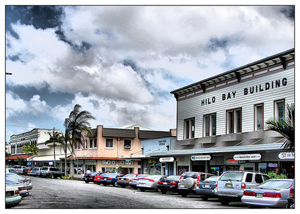 Photo: Hilo Bayfront.
Photo: Hilo Bayfront.
The ULTRA-Ex project will study changes in two core areas: socioeconomic metabolism and the dynamics of land-use and land-cover change.
The socioeconomic metabolism component is divided into four key areas of analysis: material inputs, material outputs, energy, and water. Material inputs include all materials that enter the socioeconomic systems of Hilo and Kona, such as food (both imported and locally grown), construction materials (both imported and locally extracted), and packaging materials. Material outputs include all materials that exit the socioeconomic systems of Hilo and Kona, such as municipal solid waste, recycled glass (which eventually becomes an input), and gaseous emissions to the environment. The energy area includes both primary inputs and end-use demands. The water area examines drinking water, wastewater, irrigation water, and recycled water.
Photo: Aerial view of Hilo.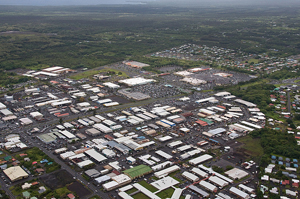
The land-use and land-cover component of the project is using both remotely-sensed and GIS data to track changes over time. For example, we are using satellite imagery to quantify the amount of agricultural land that has been converted into residential or commercial land.
Based on the diverse and comprehensive nature of this project, gathering data can be quite a challenge. We are using a combination of public databases (e.g., economic trade data, utility records, emissions inventories, NASA Landsat images), private and public reports, on-the-ground data gathering, and estimations when adequate data is not readily available. For historical data, we are relying on public and private records, archival sources, and anecdotal accounts. We are also working to digitize and analyze a number of historical maps. In cases where no data exists, it is possible to use information about existing technologies and per capita trends to reconstruct resource flows.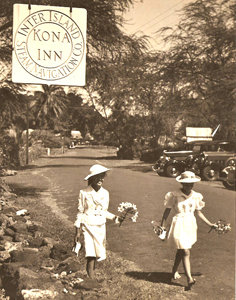
The ULTRA-Ex project is the first manifestation of the Long-Term Industrial Ecosystem-Hawai‘i Island (LIEM-Hawai‘i) effort and, as such, it will serve as a model for future projects. The LIEM-Hawai‘i project will monitor and inform resource management issues on the island for at least two decades.
The ULTRA-Ex project is a collaboration of the Center for Industrial Ecology at Yale University's School of Forestry and Environmental Studies, The Kohala Center, and the Institute of Pacific Islands Forestry (IPIF). Four co-Principal Investigators are collaborating on this project: Marian Chertow and Karen Seto, researchers from Yale, bring an expertise in metabolic and land-use/land-cover change analyses; Kamana Beamer, representing TKC, is an expert in historical geography and Hawaiian studies; and Christian Giardina, representing IPIF, is a research ecologist.
Photo: Kamana Beamer, 2008–2009 Mellon-Hawai‘i Fellow (http://kohalacenter.org/mellon/about.html) and collaborator in the ULTRA-Ex study, at the launch of the LIEM-Hawai‘i Project on May 21, 2009.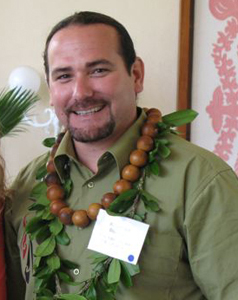
As with previous projects, we are working closely with County agencies, including the Department of Water Supply and the Department of Environmental Management. Throughout the project we will be consulting island residents and soliciting input and feedback. This ensures that our work is not only accurate, but also relevant to issues and concerns on the island.
Some of the issues that fall within the purview of this project are the limited waste assimilation capacity of the island, the extremely high energy costs on the island, and the discard of valuable resources that could be beneficially reused. We hope that our efforts to identify, quantify, and summarize material and energy flows at a regional level will provide headline indicators that can be used by the County.
On March 7–14, twelve Yale industrial ecology students, mostly master's candidates from the School of Forestry and Environmental Studies, will be conducting research on Hawai‘i Island under the direction of Professor Marian Chertow. The students are divided into four teams focusing on issues of energy, water, material inputs, and material outputs. While on the island, they will meet with a variety of individuals and organizations including County officials, representatives from private companies, and community members. Their main task will be gathering data that they will then analyze. The students will also be introduced to cultural and socioeconomic issues in the islands.
We are currently in the process of searching for funding opportunities to expand the reach of the ULTRA-Ex project. We are interested in studying resource flows not just from an urban level, but also from the ahupua‘a (watershed), island, and archipelago levels. For example, O‘ahu may be importing construction materials from the Mainland that could partially be substituted for by recovered materials from Hawai‘i Island. However, without an integrated analysis of resource flows, this opportunity will remain untapped. As we seek to live more sustainability on the land, understanding multi-level and multi-scale flows is essential for sound decision making.

The Garden at HAAS
By Chioke Mims, Garden Teacher
Photos by Debra Isabel

The vision of HAAS is to foster a community of learners. School families joined together to donate plants and composting materials to establish the garden. A Hawaiian Nutrition Education Network grant opportunity helps to fund my position as a part-time garden coordinator.
As the garden has evolved over the past nine years, its potential to serve as a focal point for student and community learning is now being realized. We have begun to host recipe sharing and cooking lessons for members of the community, and more such activities are being planned. Interest in the school garden is growing as beautiful vegetables and fruits are produced.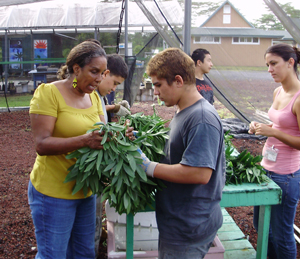
Students recognize the connection between the garden and the sources of the food they eat, and they are also beginning to understand the work that it takes to cultivate a garden. There are many challenges including weather, pests, and time. Of course, the students also need to learn how to work. Managing a school garden is challenging!
Students work in the garden as an elective class, or as part of a work training program, or as a community service project—which is a graduation requirement at HAAS. As new sections of the garden are developed, we label them accordingly. For example, we now have areas devoted to native crops, seed crops, and nitrogen fixing crops.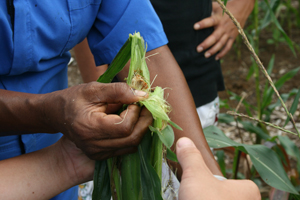
Photo: Identifying pests on garden plants.
Some of the food grown in the garden has been used to provide school snacks. As the food sources in the garden expand, more food is available to be used in school lunches. For example, we are now harvesting and serving sweet potatoes, kalo (taro) leaves, green beans, eggplants, cabbages, and green onions from the garden.
Recycled paper and cardboard from the school is utilized for weed maintenance. This material also provides an ideal environment for worms. Large composting projects are also supported by the broader HAAS school community, and these projects help us to keep excess green waste out of the County landfill.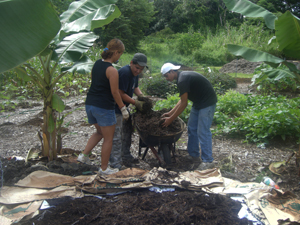
Photo: Recycling paper by layering it beneath mulch.
We are currently working to expand the garden to include a shade and green house, a large open plot, and a future 2.5-acre garden area, which is being cleared and cultivated for the production of cash crops. HAAS is poised to begin generating income by selling produce! A small animal husbandry project has also been started, and our CORD, or construction elective class, is building chicken tractors. As the garden project expands, students in this class will help construct animal shelters and farm structures, as needed.
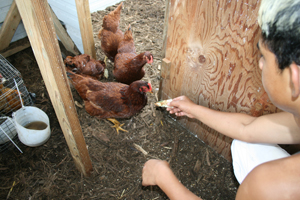
Photo: Students feed garden pests to the HAAS chickens.
Networking with The Kohala Center’s HISGN (Hawai‘i Island School Garden Network) has allowed us to share ideas and best practices with an island-wide community of school gardeners. The information and connections we make through HISGN are of great value to all involved. 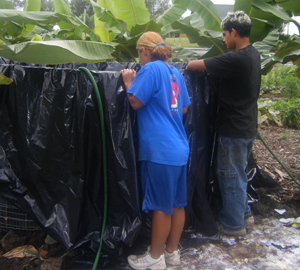
Photo: Students work on creating a fish tank at HAAS.
Due to financial shortfalls in the State Department of Education and for charter schools in particular, donations of equipment, plants, seeds, compost, garden attire, and funding are needed and welcomed. HAAS is continuing to develop its pool of volunteers, and our door is open to people who have time to invest in the garden. Volunteer farmers who are able to share their knowledge and experience with the students are also welcomed. As we all know, many hands are what it really takes to make a garden thrive and provide!
Donors or potential volunteers can call HAAS at 965-3730 and leave a message for Chioke, or e-mail her at yahdahfoods4383@aol.com.
